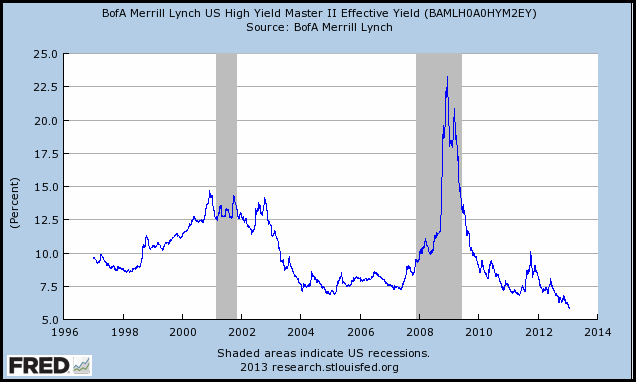Starved for Yield Try Junk Bond Funds US News
Post on: 4 Май, 2015 No Comment

Now could be a good time to allocate some of your portfolio to higher-yielding securities.
If you’ve never thought about devoting a slice of your fixed-income portfolio to high-yield bond funds, now may be a good time. High-yield bonds—often referred to as junk bonds—are those rated BB or lower. (Ratings agencies like Standard & Poor’s, Fitch, and Moody’s evaluate the riskiness of bonds—whether issued by governments or corporations—and assign ratings to the individual securities.) High-yield bonds are considered risky because the issuers have a higher probability of defaulting on their debt than those with higher ratings. Although they’re much riskier than U.S. treasuries and investment-grade corporate bonds, a small allocation can benefit investors seeking more generous yields, some experts say.
Tom Lydon, editor of ETFtrends.com, believes high-yield bond funds are one asset class to watch over the next year or so. Here’s an opportunity or maybe a trade where you can move into something that’s going to produce higher income, he says. Currently, Lydon’s favorite high-yield ETF is SPDR Barclays Capital High-Yield Bond ETF (JNK), which yields 10 percent. In this market, it’s tough to find a decent yield, he says, because most investments are currently paying very little (10-year treasuries currently yield only 2.6 percent). Lydon says investors aren’t getting enough yield in some longer-term treasuries to offset the additional risk of rising interest rates over the next year or so. But given last quarter’s strong corporate earnings and lower default rates among companies, high-yield bond funds could be an attractive alternative. He suggests allocating about 50 percent of your fixed-income portfolio to high-grade and junk corporate bond funds.
[See U.S. News ‘s list of the 100 Best Mutual Funds for the Long Term and use our Mutual Fund Score to find the best investments for you.]
On the other hand, some financial advisers are trimming high-yield holdings in their clients’ portfolios. Adam Bold, founder of The Mutual Fund Store, an investment firm, took a large position in high-yield bond funds in January 2009 when he believed high-yield funds were at their most attractive level. Bold thinks valuations are still promising, especially with interest rates as low as they are, but they’re not as appealing as they were in 2009. We’re in the attractive zone, not the really great value zone, he says. That’s why we still have exposure to high yield.
Bold favors two high-yield funds: Artio Global High Income (BJBHX) and T. Rowe Price High-Yield (PRHYX). He says both of the funds’ managers have generated consistent returns over time. Keep in mind that you may already have a fairly large allocation to high-yield bond funds through a diversified bond holding. For investors who want to dedicate just a small part of their fixed-income portfolio to high-yield bonds, Bold suggests investors look to Loomis Sayles Bond (LSBRX). an intermediate-term multisector bond fund that invests in a wide range of fixed-income securities. As of the end of June, management has allocated about 30 percent of the portfolio to high-yield securities.
Bold cautions investors against getting too comfortable with low interest rates, given that they can only go up. The Federal Reserve has kept the target range for the federal funds rate (what the Fed charges banks to borrow money on a short-term basis) between zero and 0.25 percent since December 2008 and has, since March 2009, repeated its pledge to keep rates low for an extended period. When rates finally rise, investments like treasuries will be the most negatively affected, and corporate bonds will also suffer somewhat. (Yields move in the opposite direction of price, so when rates rise, the price of bonds will inevitably fall.)
If interest rates go up, the value of those existing bonds will go down just because interest rates are higher, Bold says. But on the other hand, interest rates will only go up at a point in which the economy is doing better, and if the economy is doing better, then the likelihood of these sub-investment-grade companies being able to pay the interest—and ultimately pay back the principal on their bonds—will also go up. It’s a bit of a trade-off for investors. The Fed probably won’t raise rates until the economic picture improves, but once it does, there’s a chance that some of these junk-rated companies will be upgraded to a higher credit level like BBB or A-.














